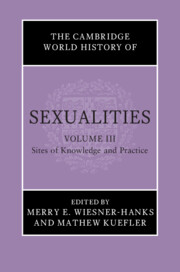Book contents
- The Cambridge World History of Sexualities
- The Cambridge World History of Sexualities
- The Cambridge World History of Sexualities
- Copyright page
- Contents
- Figures in Volume III
- Tables in Volume III
- Contributors to Volume III
- Editors’ Preface to the Series
- 1 Sex in Athens in the Fifth and Fourth Centuries bce
- 2 Sex in Rome in the First Century bce and the First Century ce
- 3 Sex in Constantinople in the Sixth Century ce
- 4 Sex in Chang’an in the Eighth and Ninth Centuries ce
- 5 Sexuality in Baghdad in the Ninth and Tenth Centuries ce
- 6 Sex in Heian-kyō (Kyoto) in the Tenth through Twelfth Centuries ce
- 7 Sex in Iceland in the Fourteenth and Fifteenth Centuries ce
- 8 Sex in Florence in the Fifteenth Century
- 9 Sexuality in Tenochtitlan in the Early Sixteenth Century
- 10 Sex in Sixteenth-Century Istanbul
- 11 Sex in Geneva in the Sixteenth Century
- 12 Sex in Eighteenth-Century Edo (Tokyo)
- 13 Sex in Eighteenth-Century Paris
- 14 Sex and Sexuality in Eighteenth-Century Philadelphia
- 15 Sex in Nineteenth-Century Cairo
- 16 Sexual Pleasures and Perils in Nineteenth-Century London
- 17 Sex in Manila in the Late Nineteenth and Early Twentieth Centuries
- 18 Sex in Lagos from the Mid-Nineteenth to the Mid-Twentieth Century
- 19 Sex in Bombay in the Late Nineteenth and Early Twentieth Centuries
- 20 Sexuality in a Distant Metropolis: Buenos Aires from the Late Nineteenth to the Mid-Twentieth Century
- 21 Sex in Early Twentieth-Century Berlin
- 22 Sex in Sydney in the Twentieth Century
- 23 Toronto the Good, Toronto the Gay: Sex and Morality in the Twentieth Century
- 24 Sex in Shanghai in the Twentieth Century: Intimate Negotiations
- 25 Sex in Twentieth-Century Rio de Janeiro
- Index
- CONTENTS TO VOLUMES I, II, AND IV
- References
13 - Sex in Eighteenth-Century Paris
Published online by Cambridge University Press: 26 April 2024
- The Cambridge World History of Sexualities
- The Cambridge World History of Sexualities
- The Cambridge World History of Sexualities
- Copyright page
- Contents
- Figures in Volume III
- Tables in Volume III
- Contributors to Volume III
- Editors’ Preface to the Series
- 1 Sex in Athens in the Fifth and Fourth Centuries bce
- 2 Sex in Rome in the First Century bce and the First Century ce
- 3 Sex in Constantinople in the Sixth Century ce
- 4 Sex in Chang’an in the Eighth and Ninth Centuries ce
- 5 Sexuality in Baghdad in the Ninth and Tenth Centuries ce
- 6 Sex in Heian-kyō (Kyoto) in the Tenth through Twelfth Centuries ce
- 7 Sex in Iceland in the Fourteenth and Fifteenth Centuries ce
- 8 Sex in Florence in the Fifteenth Century
- 9 Sexuality in Tenochtitlan in the Early Sixteenth Century
- 10 Sex in Sixteenth-Century Istanbul
- 11 Sex in Geneva in the Sixteenth Century
- 12 Sex in Eighteenth-Century Edo (Tokyo)
- 13 Sex in Eighteenth-Century Paris
- 14 Sex and Sexuality in Eighteenth-Century Philadelphia
- 15 Sex in Nineteenth-Century Cairo
- 16 Sexual Pleasures and Perils in Nineteenth-Century London
- 17 Sex in Manila in the Late Nineteenth and Early Twentieth Centuries
- 18 Sex in Lagos from the Mid-Nineteenth to the Mid-Twentieth Century
- 19 Sex in Bombay in the Late Nineteenth and Early Twentieth Centuries
- 20 Sexuality in a Distant Metropolis: Buenos Aires from the Late Nineteenth to the Mid-Twentieth Century
- 21 Sex in Early Twentieth-Century Berlin
- 22 Sex in Sydney in the Twentieth Century
- 23 Toronto the Good, Toronto the Gay: Sex and Morality in the Twentieth Century
- 24 Sex in Shanghai in the Twentieth Century: Intimate Negotiations
- 25 Sex in Twentieth-Century Rio de Janeiro
- Index
- CONTENTS TO VOLUMES I, II, AND IV
- References
Summary
Eighteenth-century Paris was the site of multiple sexual cultures ranging from permissive to conservative. All these sexual cultures operated within a set of prescriptive legal, religious, and moralistic discourses that prohibited sex outside of marriage while often supporting sexual pleasure within it. Many Parisians ignored these prescriptions, often with impunity. The police concerned themselves with public sex and intervened in private affairs only when asked to do so. Paris was home to a diverse permissive sexual culture. It was comprised of a portion of the financial, social, political, and intellectual elite, often identified as libertines, for whom sex outside marriage was both widespread and widely accepted. It also included men who had sex with each other as part of Paris’s extensive sodomitical subculture, though there is little evidence of a modern homosexual identity. Prostitution was endemic in Paris, encompassing numerous forms of transactional sex that translated into a sort of hierarchy, with women kept as mistresses by men of the elite at the top and those catering to marginal men at the bottom. We know least about the sex lives of other ordinary people, though evidence suggests many had sex outside of marriage and many cared deeply for their spouses.
Keywords
- Type
- Chapter
- Information
- The Cambridge World History of Sexualities , pp. 261 - 284Publisher: Cambridge University PressPrint publication year: 2024



